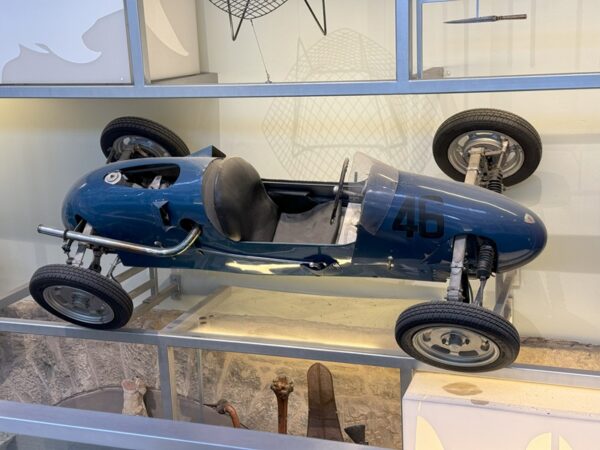
The precarious location of this racing car is down to its honoured display at the National Museum of Scotland in Edinburgh. It may be a suitably dramatic way to show famous examples of Scottish ingenuity, but it makes photography rather challenging.
Joseph Potts Limited was founded in the late 19th century by the eponymous Irish immigrant who had settled in Bellshill, Lanarkshire. It appears that the company manufactured horse-drawn carriages; Joseph also hired some of these out, one of his customers being a local undertaker. Joseph later took over this funeral director’s business, and modified his carriages so that they could be used as hearses when necessary.
The business also included a small engineering works. Joseph’s grandson, also Joseph, or Joe, Potts, expanded the engineering side of the business in the mid-1930s to supply motorcycle components and, during World War II, specialist armament parts. After the war, Joe Potts continued to develop motorcycles and ran a highly successful team of racers.
In the early postwar period Joe started to compete in races and hill climbs in a Cooper Formula 3 car. But he believed that he could do better than Cooper, so in 1950 he and his chief designer Willie Rogerson designed and built their own JP Formula 3 car. Over the next five years they built just over 30 cars. The engineering company continued to work on engineering projects until Joe died in 1982.
The JP cars are among the few single-seater racing cars to be built in Scotland, and predate such makes as Fisher, Jasag, Raptor and Rotor.
Only five JP cars are thought to survive, including one raced by Ron Flockhart, who went on to win the Le Mans 24 Hours in 1956 and 1957, driving for Ecurie Ecosse in Jaguar D-Types.
Other notable drivers of JP Formula 3 cars were Marshall Watson, father of Grand Prix driver John Watson, and Ninian Sanderson, who shared the winning D-Type with Flockhart at Le Mans in 1956.







Leave a Comment